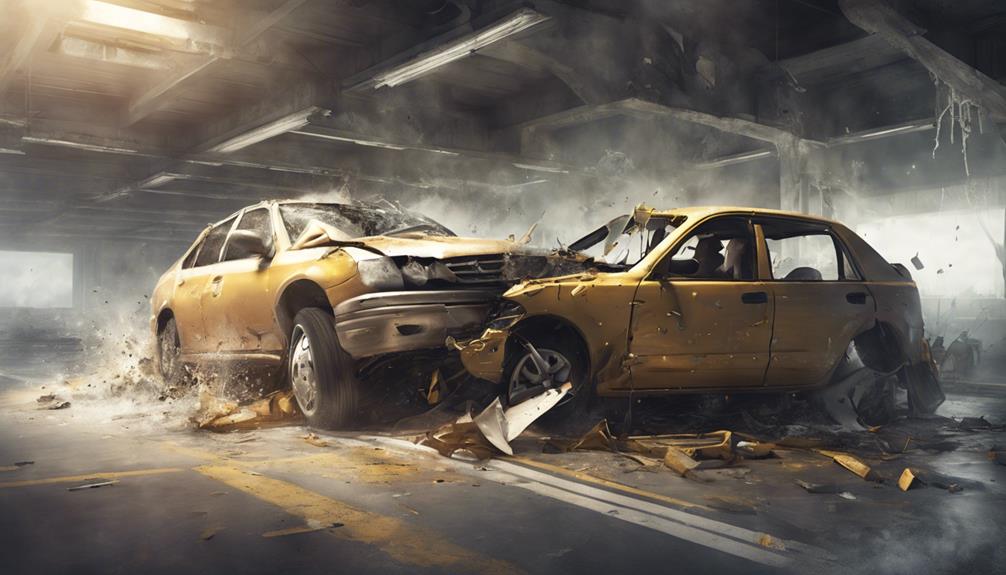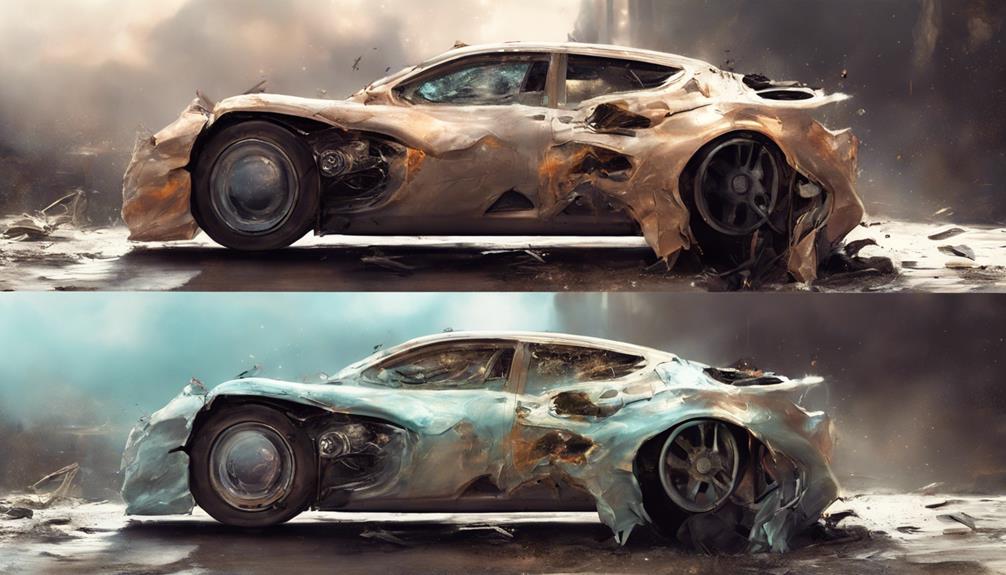Have you ever wondered if top-rated cars truly guarantee the safest outcome in crashes? While safety ratings provide valuable insights, the reality of real-world accidents often unveils a different story. Factors like crash test limitations, driver assistance technologies, and even human behavior play pivotal roles in determining a vehicle's safety in the event of a collision. As you navigate the complex landscape of car safety, it's essential to understand the nuances beyond just the ratings to ensure you make the most informed decision for your well-being on the road.
Safety Ratings Vs. Real-World Performance

When comparing safety ratings to real-world performance, it is important to consider the discrepancies that may exist between the two metrics. While safety ratings are often based on controlled crash simulations conducted in laboratory settings, real-world data provides insights into how vehicles actually perform in various crash scenarios on the roads. Crash simulations, although valuable for initial assessments, may not always accurately reflect the complexities and variables present in actual accidents.
Real-world data offers a more holistic view of a vehicle's safety by taking into account factors such as driver behavior, road conditions, and unexpected variables that can influence the outcome of a crash. Unlike crash simulations that follow predefined patterns, real-world data captures the unpredictability and randomness of accidents, providing a more accurate representation of a car's safety performance in practical situations.
Crash Tests: Limitations and Considerations
Considering crash tests, it is crucial to understand their limitations and key considerations for evaluating vehicle safety performance accurately. When delving into crash test reliability, limitations, and safety ratings accuracy, concerns arise that can influence your perception of a vehicle's safety. Here are four essential points to keep in mind:
- Crash Test Variability: Crash tests provide valuable data, but variables such as test conditions, vehicle configurations, and crash dummies can impact results. Understanding these variations is vital to interpreting the test outcomes correctly and applying them to real-world scenarios effectively.
- Sensitivity to Test Parameters: Different crash tests focus on specific types of collisions or impact points. This specialization can lead to discrepancies in safety ratings, as a vehicle excelling in one test might perform poorly in another. Being aware of the test parameters ensures a comprehensive evaluation of a car's safety features.
- Limited Scope of Crash Tests: While crash tests simulate common accident scenarios, they cannot encompass every possible situation. Factors like extreme weather conditions, unusual collision angles, or multiple-vehicle accidents may not be fully represented in standard crash tests, affecting the overall assessment of a vehicle's safety capabilities.
- Technology Advancements and Updates: As vehicle safety technology evolves, older crash test results might not accurately reflect the current safety standards. Keeping abreast of technological advancements and updated safety ratings is essential to making informed decisions about vehicle safety.
Understanding Crash Test Procedures

Understanding crash test procedures is essential for accurately assessing a vehicle's safety performance and reliability. When it comes to crash test accuracy, advancements in safety technology have significantly improved the reliability of these tests in determining how well a car protects its occupants in the event of a crash.
Below is a comparison table that highlights the key elements of crash test procedures and how safety technology advancements have influenced them:
| Crash Test Procedures | Safety Technology Advancements |
|---|---|
| Rigorous impact simulations | Integration of electronic stability control systems |
| Assessment of structural integrity | Implementation of advanced driver assistance systems |
| Evaluation of airbag effectiveness | Utilization of pre-collision braking systems |
| Analysis of occupant protection | Inclusion of lane departure warning systems |
| Testing for side and rear impacts | Incorporation of blind-spot monitoring technology |
Beyond Ratings: Driver Assistance Technologies
When considering driver assistance technologies, it is crucial to evaluate their impact on vehicle safety. Comparing the safety features of different technologies can provide insights into their effectiveness in preventing accidents. Additionally, correlating these technologies with crash test results can offer a comprehensive understanding of their real-world safety implications.
Impact of Tech
Driver assistance technologies play a crucial role in enhancing vehicle safety beyond traditional crash ratings. These advancements not only improve safety performance but also revolutionize how we perceive vehicle protection. Here are four ways these technologies impact safety:
- Enhanced Collision Avoidance: Tech advancements enable quicker response times, aiding in avoiding potential collisions.
- Improved Crash Prediction: The accuracy of crash test results is heightened with the integration of advanced technologies, ensuring better safety outcomes.
- Increased Driver Awareness: These features enhance driver attentiveness, reducing the risk of accidents caused by human error.
- Quicker Emergency Response: With tech advancements, emergency services can be notified promptly in case of a crash, potentially saving lives.
Stay informed and empowered with these technological developments for safer journeys.
Safety Features Comparison
Exploring the comparative effectiveness of driver assistance technologies goes beyond traditional crash safety ratings, delving into the intricate realm of safety feature analysis. When evaluating safety features, consider the incorporation of crash avoidance technology, such as automatic emergency braking and lane-keeping assist systems. These technologies can significantly reduce the likelihood of accidents by actively assisting the driver in avoiding potential hazards. Additionally, the choice of vehicle construction materials plays a crucial role in enhancing safety. Cars constructed with high-strength materials like boron steel and aluminum offer better protection in the event of a crash. Understanding how these features work together can provide you with a comprehensive view of a vehicle's safety capabilities, empowering you to make informed decisions when selecting a car for optimal protection.
Crash Test Results
To understand the effectiveness of driver assistance technologies in enhancing crash safety beyond traditional ratings, it is crucial to analyze specific crash test results that highlight the impact of these advanced safety features. When delving into crash dynamics and impact testing, consider the following:
- Witness how driver assistance systems react in simulated emergency braking scenarios, shedding light on their ability to prevent collisions.
- Explore how these technologies perform in side-impact crash simulations, showcasing their role in mitigating injuries to occupants.
- Review rear-end collision tests to understand how these features can reduce the severity of accidents.
- Examine rollover tests to see how driver assistance technologies contribute to enhancing vehicle stability and reducing the risk of rollovers.
Importance of Vehicle Size and Weight
When considering crash safety, the size of a vehicle plays a critical role in determining the level of protection it offers. Additionally, the weight of a car can significantly impact the chances of survival in the event of a collision. It is essential to note that smaller cars tend to be riskier in crashes due to their reduced size and weight.
Size Impacts Crash Safety
The relationship between vehicle size and weight significantly influences crash safety outcomes. When considering safety regulations and crash dynamics, it becomes evident that:
- Larger vehicles tend to offer better protection in crashes due to their ability to absorb impact forces over a larger crumple zone.
- Heavier vehicles often fare better in collisions with lighter ones, as the momentum difference can result in less severe damage to the heavier vehicle.
- Compact cars, while fuel-efficient and maneuverable, may be at a disadvantage in crashes with larger vehicles due to their smaller size and weight.
- The structural design of a vehicle plays a crucial role in how it distributes and absorbs crash forces, impacting the overall safety performance.
Weight Influences Crash Survival
In crash scenarios, the weight of a vehicle significantly impacts the likelihood of survival for occupants, as it influences the distribution and absorption of impact forces. Weight distribution plays a crucial role in crash dynamics, affecting how energy is dissipated during a collision. Heavier vehicles tend to fare better in crashes due to their ability to withstand and distribute impact forces more effectively than lighter vehicles. This is why larger and heavier vehicles are often associated with increased safety in accidents. Below is a table highlighting how weight influences crash survival:
| Vehicle Weight | Impact on Crash Survival |
|---|---|
| Lighter | Higher risk of injuries |
| Heavier | Enhanced protection |
| Balanced | Optimal crash resilience |
| Ultra-Lightweight | Extreme vulnerability |
| Ultra-Heavyweight | Potential for overkill |
Small Cars Riskier
Considering the significant impact of weight on crash survival as discussed earlier, the increased risk associated with smaller cars becomes apparent due to their reduced mass and potential for greater vulnerability in collisions. Small car safety is a crucial concern due to their limited size and weight, which can compromise occupant protection. Crash test accuracy is essential in revealing the potential dangers of smaller vehicles, highlighting the need for thorough assessments to accurately depict real-world scenarios. Understanding the implications of vehicle size and weight on safety can empower you to make informed decisions when selecting a car. Here are four key points to consider:
- Lighter cars may experience more severe damage in crashes.
- Small cars have less protective space for occupants.
- Crash forces are more concentrated in smaller vehicles.
- Larger vehicles tend to perform better in crash tests.
Impact of Human Factors in Crashes
Examining the role of human factors in crashes reveals crucial insights into the dynamics of vehicular accidents. When it comes to driver behavior, crash outcomes are heavily influenced. Human error plays a significant role in determining collision severity. Understanding these factors is vital for enhancing safety on the roads.
| Human Factor | Impact on Crashes | Examples |
|---|---|---|
| Distraction | Increases the likelihood of accidents | Texting while driving, adjusting the radio |
| Fatigue | Slows reaction times and impairs judgment | Falling asleep at the wheel, drowsy driving |
| Aggressive Driving | Raises the risk of collisions and road rage incidents | Speeding, tailgating, frequent lane changes |
| Impaired Driving | Leads to impaired coordination and decision-making | Driving under the influence of alcohol |
Choosing the Safest Car for You

To ensure optimal safety on the road, select a car that prioritizes crashworthiness and advanced safety features. When choosing the safest car for you, consider the following factors to make an informed decision:
- Safety Features Evaluation: Look for vehicles with top safety ratings from organizations like the Insurance Institute for Highway Safety (IIHS) and the National Highway Traffic Safety Administration (NHTSA). Evaluate features such as airbags, antilock brakes, electronic stability control, and advanced driver assistance systems (ADAS).
- Reliability Factors: Opt for cars with a strong reputation for reliability. Reliable vehicles are less likely to have unexpected malfunctions that could compromise safety when you need it the most.
- Crash Avoidance Systems: Prioritize cars equipped with advanced crash avoidance technologies like automatic emergency braking, lane-keeping assistance, blind-spot monitoring, and adaptive cruise control. These systems can help prevent accidents and mitigate their severity.
- Budget Considerations: While safety is paramount, consider your budget constraints. Research affordable options that still offer essential safety features to strike a balance between protection and cost-effectiveness.
Frequently Asked Questions
How Do Safety Ratings Differ Between Different Organizations and How Can Consumers Compare Them Effectively?
When comparing safety ratings from different organizations, ensure you consider rating accuracy. Like the saying goes, "Don't judge a book by its cover." Research methodologies, crash tests, and real-world data can help you make informed decisions.
Are There Any Common Misconceptions About Vehicle Safety Ratings That Consumers Should Be Aware Of?
When it comes to safety features and crash simulations, remember that top-rated cars might excel in specific areas but could have weaknesses in others. Don't assume all top-rated cars are always the safest in crashes.
How Do Advancements in Technology Impact the Safety of Newer Vehicles Compared to Older Models?
When considering the impact of technology on vehicle safety advancements, newer models often integrate advanced features like automatic emergency braking and lane departure warnings, enhancing crash avoidance capabilities compared to older vehicles.
What Role Do Vehicle Design and Engineering Play in Crash Safety Beyond Crash Test Ratings?
When considering crash safety, vehicle design innovations and crash dynamics go beyond simple ratings. Engineering intricacies like crumple zones, airbag deployment, and material strength impact real-world safety outcomes, shaping how well a car protects you.
How Do External Factors, Such as Road Conditions and Weather, Impact the Safety of a Vehicle in a Crash?
As the environment shifts, so do crash dynamics. Road conditions and weather play a pivotal role in vehicle safety during a crash. Understanding how external factors impact safety can help you navigate the roads with caution.



